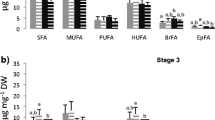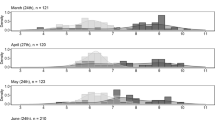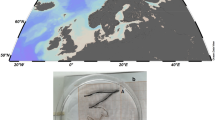Abstract
Maternal provisioning of animal embryos may be entirely through yolk deposited in the unfertilized egg (lecithotrophy) or may include post-fertilization nutrient transfer (matrotrophy) in varying degrees. Current theory suggests that the extent of post-fertilization provisioning is resource-dependent, with higher levels of matrotrophy being advantageous in more productive environments. In this study, we investigated post-fertilization embryo provisioning in a livebearing fish, Poecilia mexicana, from two different habitats (a toxic cave and a non-toxic surface habitat) that impose different energetic demands and therefore differ in resources available for reproduction. We predicted that fish in the benign habitat would be more matrotrophic than those from the toxic cave. We used two different techniques for this assay: (1) the matrotrophy-index analysis (MI) for field-collected fish and (2) both MI and radio-tracer assay for laboratory-reared females. According to the interpretation of the matrotrophy index, both populations are purely lecithotrophic, while the radio-tracer assay found females from both populations to actively transfer nutrients to developing embryos at approximately the same rate. Our results suggest that P. mexicana, which was traditionally classified as lecithotrophic, is capable of incipient matrotrophy, and that matrotrophy can contribute to embryo provisioning even in populations from resource-limited environments. Furthermore, the analysis of laboratory-reared animals provides evidence for a genetic component to the large offspring size in cave mollies, which had so far only been described from the field. Specifically, our results suggest matrotrophy occurs in species interpreted as lecithotrophic using the MI approach. Hence, to avoid misclassification, both techniques should ideally be employed in concert, rather than individually. Finally, our results provide further insights into the possible evolutionary pathway from lecithotrophic oviparity to matrotrophic viviparity.


Similar content being viewed by others
References
Blackburn DG (1992) Convergent evolution of viviparity, matrotrophy, and specializations for fetal nutrition in reptiles and other vertebrates. Am Zool 32:313–321
Blackburn DG (1994) Standardized criteria for the recognition of developmental nutritional patterns in squamate reptiles. Copeia 1994:925–935
Blackburn DG (1999) Viviparity and oviparity: evolution and reproductive strategies. In: Knobil TE, Neill JD (eds) Encyclopedia of reproduction. Academic Press, New York, pp 994–1003
Blackburn DG (2005a) Evolutionary origins of viviparity in fishes. In: Grier H, Uribe MC (eds) Viviparous fishes. New Life Publications, Homestead, pp 287–301
Blackburn DG (2005b) Amniote perspectives on the evolutionary origins of viviparity and placentation. In: Grier H, Uribe MC (eds) Viviparous fishes. New Life Publications, Homestead, pp 301–322
Chapman LJ, Chapman CA (1993) Desiccation, flooding, and the behavior of Poecilia gilii (Pisces: Poeciliidae). Ichthyol Explor Freshw 4:279–287
Chapman LJ, Kramer DL, Chapman CA (1991) Population dynamics of the fish Poecilia gillii (Poeciliidae) in the pools of an intermittent tropical stream. J Anim Ecol 60:441–453
Constantz GD (1989) Reproductive biology of poeciliid fishes. In: Meffe GK, Snelson FF Jr (eds) Ecology & evolution of livebearing fishes. Prentice Hall, Englewood Cliffs, pp 33–50
Crespi BJ, Semeniuk C (2004) Parent-offspring conflict in the evolution of vertebrate reproductive mode. Am Nat 163:635–653
Culver DC (2005) Life history evolution. In: Culver DC, White WB (eds) Encyclopedia of caves. Elsevier, Amsterdam, pp 346–349
DeMarais A, Oldis D (2005) Matrotrophic transfer of fluorescent microspheres in poeciliid fishes. Copeia 2005:632–636
Gordon MS, Rosen DE (1962) A cavernicolous form of the poeciliid fish Poecilia sphenops from Tabasco, Mexico. Copeia 1962:360–368
Grieshaber MK, Völkel S (1998) Animal adaptations for tolerance and exploitation of poisonous sulfide. Ann Rev Physiol 60:33–53
Haynes JL (1995) Standardized classification of poeciliid development for life-history studies. Copeia 1995:147–154
Henrich S (1988) Variation in offspring size of the poeciliid fish Heterandria formosa in relation to fitness. Oikos 51:13–18
Hose LD, Pisarowicz JA (1999) Cueva de Villa Luz, Tabasco, Mexico: reconnaissance study of an active sulfur spring cave and ecosystem. J Cave Karst Stud 61:13–21
Hüppop K (2000) How do cave animals cope with the food scarcity in caves? In: Wilkens H, Culver DC, Humphreys WF (eds) Subterranean ecosystems. Ecosystems of the world, vol 30. Elsevier, Amsterdam, pp 159–184
Ip YK, Kuah SSL, Chew SF (2004) Strategies adopted by the mudskipper Boleophthalmus boddaerti to survive sulfide exposure in normoxia or hypoxia. Physiol Biochem Zool 77:824–837
Kunz YW (2004) Developmental biology of teleost fishes. Springer, Dordrecht
Langecker TG, Wilkens H, Parzefall J (1996) Studies on the trophic structure of an energy-rich Mexican cave (Cueva de las Sardinas) containing sulfurous water. Mémoires de Biospéologie 23:121–125
Marsh-Matthews E (2009) Matrotrophy. In: Evans J, Pilastro A, Schlupp I (eds) Ecology and evolution of poeciliid fishes, chapter 22. University of Chicago Press, Chicago (in press)
Marsh-Matthews E, Deaton R (2006) Resources and offspring provisioning: a test of the Trexler–DeAngelis model for matrotrophy evolution. Ecology 87:3014–3020
Marsh-Matthews E, Skierkowski P, DeMarais A (2001) Direct evidence for mother-to-embryo transfer of nutrients in the livebearing fish Gambusia geiseri. Copeia 2001:1–6
Marsh-Matthews E, Brooks M, Deaton R, Tan H (2005) Effects of maternal and embryo characteristics on post-fertilization provisioning in fishes of the genus Gambusia. Oecologia 144:12–24
Marsh-Matthews E, Deaton R, Brooks M (2010) Survey of matrotrophy in lecithotrophic poeciliids. In: Uribe MC, Grier HJ (eds) Viviparous fishes II, the proceedings of the III international symposium on viviparous fishes. New Life Publications, Homestead (in press)
MedCalc (2008) MedCalc software version 9.5. Mariakerke, Belgium
Miller RR (2005) Freshwater fishes of México. University of Chicago Press, Chicago
Pires MN, McBride KE, Reznick DN (2007) Interpopulation variation in life-history traits of Poeciliopsis prolifica: Implications for the study of placental evolution. J Exp Zool 307A:113–125
Pires MN, Banet AI, Pollux BJA, Reznick DN (2010) A review of life-history patterns in poeciliine fishes. In: Evans J, Pilastro A, Schlupp I (eds) Ecology and evolution of poeciliid fishes, chapter 3. University of Chicago Press, Chicago (in press)
Plath M, Heubel KU, García de León FJ, Schlupp I (2005) Cave molly females like well-fed males. Behav Ecol Sociobiol 58:144–151
Plath M, Hauswaldt JS, Moll K, Tobler M, García de León FJ, Schlupp I, Tiedemann R (2007a) Local adaptation and pronounced genetic differentiation in an extremophile fish, Poecilia mexicana, inhabiting a Mexican cave with toxic hydrogen sulphide. Mol Ecol 16:967–976
Plath M, Tobler M, Riesch R, García de León FJ, Giere O, Schlupp I (2007b) Survival in an extreme habitat: the role of behavior and energy limitation. Naturwissenschaften 94:991–996
Poulson TL, Lavoie KH (2000) The trophic basis of subterranean ecosystems. In: Wilkens H, Culver DC, Humphries WF (eds) Subterranean ecosystems. Ecosystems of the world, vol 30. Elsevier, Amsterdam, pp 231–249
Poulson TL, White WB (1969) The cave environment. Science 165:971–981
Reznick DN, Miles DB (1989) A review of life history patterns in poeciliids fishes. In: Meffe GK, Snelson FF Jr (eds) Ecology & evolution of livebearing fishes (poeciliidae). Prentice Hall, Englewood Cliffs, pp 125–149
Reznick D, Yang AP (1993) The influence of fluctuating resources on life history: patterns of allocation and plasticity in female guppies. Ecology 74:2011–2019
Reznick DN, Mateos M, Springer MS (2002) Independent origins and rapid evolution of the placenta in the fish genus Poeciliopsis. Science 298:1018–1020
Reznick DN, Hrbek T, Caura S, De Greef J, Roff D (2007) Life history of Xenodexia ctenolepis: implications for life history evolution in the family Poeciliidae. Biol J Linnean Soc 92:77–85
Riesch R, Schlupp I, Tobler M, García de León FJ, Plath M (2006) Reduction of the association preference for conspecifics in cave-dwelling Atlantic mollies, Poecilia mexicana. Behav Ecol Sociobiol 60:794–802
Riesch R, Duwe V, Herrmann N, Padur L, Ramm A, Scharnweber K, Schulte M, Schulz-Mirbach T, Ziege M, Plath M (2009a) Variation along the shy-bold continuum in extremophile fishes (Poecilia mexicana, Poecilia sulphuraria). Behav Ecol Sociobiol 63:1515–1526
Riesch R, Tobler M, Plath M, Schlupp I (2009b) Offspring number in a livebearing fish (Poecilia mexicana, Poeciliidae): reduced fecundity and reduced plasticity in a population of cave mollies. Environ Biol Fishes 84:89–94
Riesch R, Plath M, Schlupp I (2010) Toxic hydrogen sulfide and dark caves: life history adaptations in a livebearing fish (Poecilia mexicana, Poeciliidae). Ecology (in press)
Schrader M, Travis J (2005) Population differences in pre- and post-fertilization offspring provisioning in the Least Killifish Heterandria formosa. Copeia 2005:649–656
Scrimshaw NS (1944) Superfetation in poeciliid fishes. Copeia 1944:180–183
Scrimshaw NS (1945) Embryonic development in poeciliid fishes. Biol Bull 88:233–246
Sibly RM, Calow P (1989) A life-cycle theory of responses to stress. Biol J Linnean Soc 37:101–116
Stewart JR, Thompson MB (2000) Evolution of placentation among squamate reptiles: recent research and future directions. Comp Biochem Physiol A 127:411–431
Swain R, Jones SM (1997) Maternal-fetal transfer of 3H-labelled leucine in the viviparous lizard Niveoscincus metallicus (scincidae: Lygosominae). J Exp Zool 277:139–145
Thibault RE, Schultz RJ (1978) Reproductive adaptations among viviparous fishes (Cyprinodontiformes: Poeciliidae). Evolution 32:320–333
Thompson MB, Stewart JR, Speake BK (2000) Comparison of nutrient transport across the placenta of lizards differing in placental complexity. Comp Biochem Physiol A 127:469–479
Tobler M (2008) Divergence in trophic ecology characterizes colonization of extreme habitats. Biol J Linnean Soc 95:517–528
Tobler M, Schlupp I, Heubel KU, Riesch R, García de León FJ, Giere O, Plath M (2006) Life on the edge: hydrogen sulfide and the fish communities of a Mexican cave and surrounding waters. Extremophiles 10:577–585
Tobler M, DeWitt TJ, Schlupp I, García de León FJ, Herrmann R, Feulner PGD, Tiedemann R, Plath M (2008a) Toxic hydrogen sulfide and dark caves: phenotypic and genetic divergence across two abiotic environmental gradients in Poecilia mexicana. Evolution 62:2643–2659
Tobler M, Riesch R, García de León FJ, Schlupp I, Plath M (2008b) A new and morphologically distinct population of cavernicolous Poecilia mexicana (Poeciliidae: Teleostei). Environ Biol Fishes 82:101–108
Tobler M, Riesch RW, Tobler CM, Plath M (2009a) Compensatory behaviour in response to sulphide-induced hypoxia affects time budgets, feeding efficiency, and predation risk. Evol Ecol Res 11:935–948
Tobler M, Riesch R, Tobler CM, Schulz-Mirbach T, Plath M (2009b) Natural and sexual selection against immigrants maintains differentiation among micro-allopatric populations. J Evol Biol 22:2298–2304
Trexler JC (1985) Variation in the degree of viviparity in the sailfin molly, Poecilia latipinna. Copeia 1985:999–1004
Trexler JC (1997) Resource availability and plasticity in offspring provisioning: embryo nourishment in sailfin mollies. Ecology 78:1370–1381
Trexler JC, DeAngelis DL (2003) Resource allocation in offspring provisioning: an evaluation of the conditions favoring the evolution of matrotrophy. Am Nat 162:574–585
Turcotte MM, Pires MN, Vrijenhoek RC, Reznick DN (2008) Pre- and post-fertilization maternal provisioning in livebearing fish species and their hybrids (Poeciliidae: Poeciliopsis). Funct Ecol 22:1118–1124
Turner CL (1940) Superfetation in viviparous cyprinodont fishes. Copeia 1940:88–91
Wourms JP, Grove BD, Lombardi J (1988) The maternal embryonic relationship in viviparous fishes. In: Hoar WS, Randall DJ (eds) Fish physiology, vol XI. Academic Press, New York, pp 1–119
Acknowledgments
The authors thank D. Blackburn, M. Reichard and two anonymous reviewers for helpful advice and comments, and the Mexican Government (Permiso de Pesca de Fomento: DGOPA/02232/230706/1079) for kindly providing permits. R.R. would like to thank D. Reznick for his instruction on life-history sampling techniques and for discussion. Financial support came from NSF (DEB-0743406). This work represents partial fulfillment of the PhD requirements for R.R.
Author information
Authors and Affiliations
Corresponding author
Rights and permissions
About this article
Cite this article
Riesch, R., Plath, M., Schlupp, I. et al. Matrotrophy in the cave molly: an unexpected provisioning strategy in an extreme environment. Evol Ecol 24, 789–801 (2010). https://doi.org/10.1007/s10682-009-9335-z
Received:
Accepted:
Published:
Issue Date:
DOI: https://doi.org/10.1007/s10682-009-9335-z




